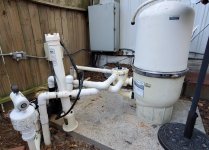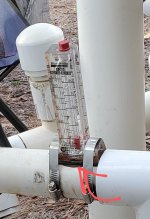Since I already got the pump out, I would like to collect everyone's opinion on the best course of action.
Glued-un elbow just downstream from the pump has a small leak. I have verified that the leak is from the elbow. It is upper glued joint in the picture; lower one is pump union joint.
Dad said i can either patch it with fiberglass wrap or replace pipe section between the pump and filter.
What is the best way to go? Please share your input.
And if I'm replacing pipe, I might get rid of 3-elbow maze of a return section after MPV. Please comment on that, too.
Thank you!
Ig


Glued-un elbow just downstream from the pump has a small leak. I have verified that the leak is from the elbow. It is upper glued joint in the picture; lower one is pump union joint.
Dad said i can either patch it with fiberglass wrap or replace pipe section between the pump and filter.
What is the best way to go? Please share your input.
And if I'm replacing pipe, I might get rid of 3-elbow maze of a return section after MPV. Please comment on that, too.
Thank you!
Ig








